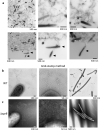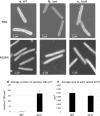Colony spreading of the gliding bacterium Flavobacterium johnsoniae in the absence of the motility adhesin SprB
- PMID: 33441737
- PMCID: PMC7807042
- DOI: 10.1038/s41598-020-79762-5
Colony spreading of the gliding bacterium Flavobacterium johnsoniae in the absence of the motility adhesin SprB
Abstract
Colony spreading of Flavobacterium johnsoniae is shown to include gliding motility using the cell surface adhesin SprB, and is drastically affected by agar and glucose concentrations. Wild-type (WT) and ΔsprB mutant cells formed nonspreading colonies on soft agar, but spreading dendritic colonies on soft agar containing glucose. In the presence of glucose, an initial cell growth-dependent phase was followed by a secondary SprB-independent, gliding motility-dependent phase. The branching pattern of a ΔsprB colony was less complex than the pattern formed by the WT. Mesoscopic and microstructural information was obtained by atmospheric scanning electron microscopy (ASEM) and transmission EM, respectively. In the growth-dependent phase of WT colonies, dendritic tips spread rapidly by the movement of individual cells. In the following SprB-independent phase, leading tips were extended outwards by the movement of dynamic windmill-like rolling centers, and the lipoproteins were expressed more abundantly. Dark spots in WT cells during the growth-dependent spreading phase were not observed in the SprB-independent phase. Various mutations showed that the lipoproteins and the motility machinery were necessary for SprB-independent spreading. Overall, SprB-independent colony spreading is influenced by the lipoproteins, some of which are involved in the gliding machinery, and medium conditions, which together determine the nutrient-seeking behavior.
Conflict of interest statement
The authors declare no competing interests.
Figures








Similar articles
-
Biofilm Spreading by the Adhesin-Dependent Gliding Motility of Flavobacterium johnsoniae. 1. Internal Structure of the Biofilm.Int J Mol Sci. 2021 Feb 14;22(4):1894. doi: 10.3390/ijms22041894. Int J Mol Sci. 2021. PMID: 33672911 Free PMC article.
-
Biofilm Spreading by the Adhesin-Dependent Gliding Motility of Flavobacterium johnsoniae: 2. Role of Filamentous Extracellular Network and Cell-to-Cell Connections at the Biofilm Surface.Int J Mol Sci. 2021 Jun 27;22(13):6911. doi: 10.3390/ijms22136911. Int J Mol Sci. 2021. PMID: 34199128 Free PMC article.
-
The Carboxy-Terminal Region of Flavobacterium johnsoniae SprB Facilitates Its Secretion by the Type IX Secretion System and Propulsion by the Gliding Motility Machinery.J Bacteriol. 2019 Sep 6;201(19):e00218-19. doi: 10.1128/JB.00218-19. Print 2019 Oct 1. J Bacteriol. 2019. PMID: 31262839 Free PMC article.
-
Flavobacterium gliding motility and the type IX secretion system.Curr Opin Microbiol. 2015 Dec;28:72-7. doi: 10.1016/j.mib.2015.07.016. Epub 2015 Oct 23. Curr Opin Microbiol. 2015. PMID: 26461123 Review.
-
Cytophaga-flavobacterium gliding motility.J Mol Microbiol Biotechnol. 2004;7(1-2):63-71. doi: 10.1159/000077870. J Mol Microbiol Biotechnol. 2004. PMID: 15170404 Review.
Cited by
-
Transposon mutagenesis and genome sequencing identify two novel, tandem genes involved in the colony spreading of Flavobacterium collinsii, isolated from an ayu fish, Plecoglossus altivelis.Front Cell Infect Microbiol. 2023 Feb 10;13:1095919. doi: 10.3389/fcimb.2023.1095919. eCollection 2023. Front Cell Infect Microbiol. 2023. PMID: 36844397 Free PMC article.
-
Co-zorbs: Motile, multispecies biofilms aid transport of diverse bacterial species.Proc Natl Acad Sci U S A. 2025 Feb 11;122(6):e2417327122. doi: 10.1073/pnas.2417327122. Epub 2025 Feb 3. Proc Natl Acad Sci U S A. 2025. PMID: 39899715 Free PMC article.
-
Ca2+ Dependent Formation/Collapse of Cylindrical Ca2+-ATPase Crystals in Scallop Sarcoplasmic Reticulum (SR) Vesicles: A Possible Dynamic Role of SR in Regulation of Muscle Contraction.Int J Mol Sci. 2023 Apr 11;24(8):7080. doi: 10.3390/ijms24087080. Int J Mol Sci. 2023. PMID: 37108240 Free PMC article.
-
Parallel evolution of alternate morphotypes of Chryseobacterium gleum during experimental evolution with Caenorhabditis elegans.FEMS Microbiol Ecol. 2024 Apr 10;100(5):fiae039. doi: 10.1093/femsec/fiae039. FEMS Microbiol Ecol. 2024. PMID: 38549432 Free PMC article.
-
Pectin Induced Colony Expansion of Soil-Derived Flavobacterium Strains.Front Microbiol. 2021 Apr 6;12:651891. doi: 10.3389/fmicb.2021.651891. eCollection 2021. Front Microbiol. 2021. PMID: 33889143 Free PMC article.
References
Publication types
MeSH terms
Substances
Supplementary concepts
LinkOut - more resources
Full Text Sources
Other Literature Sources

